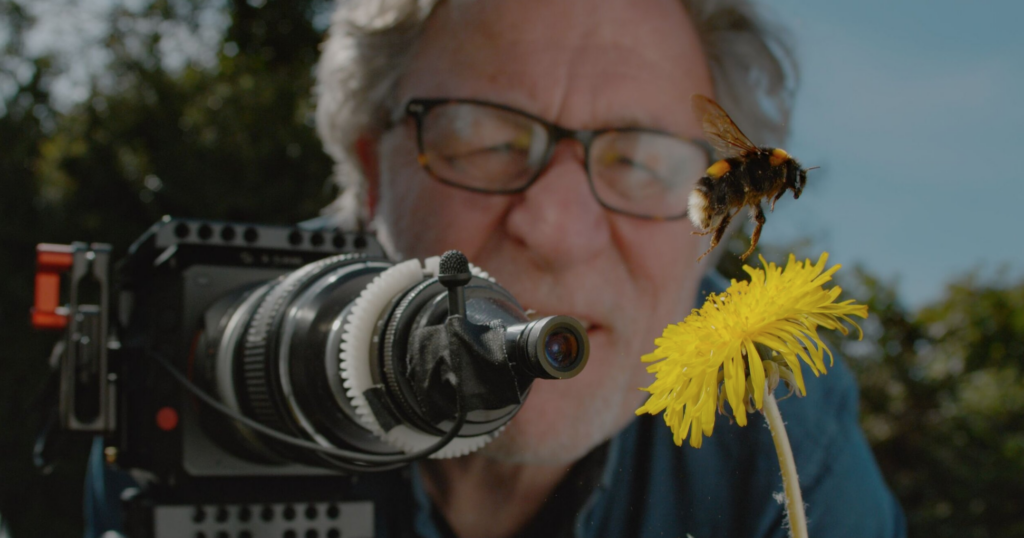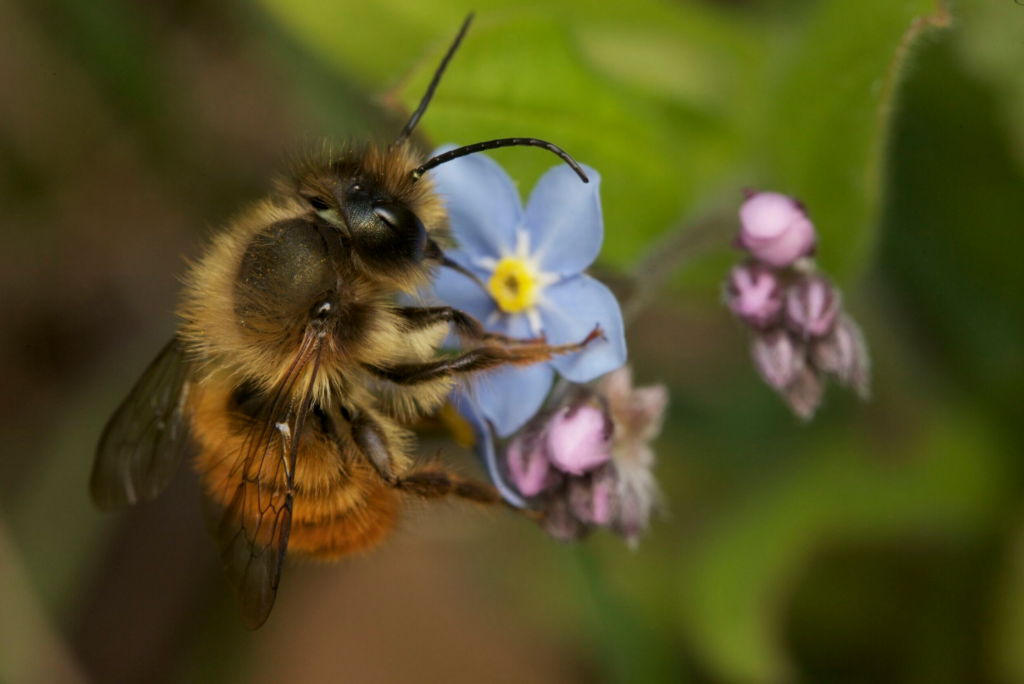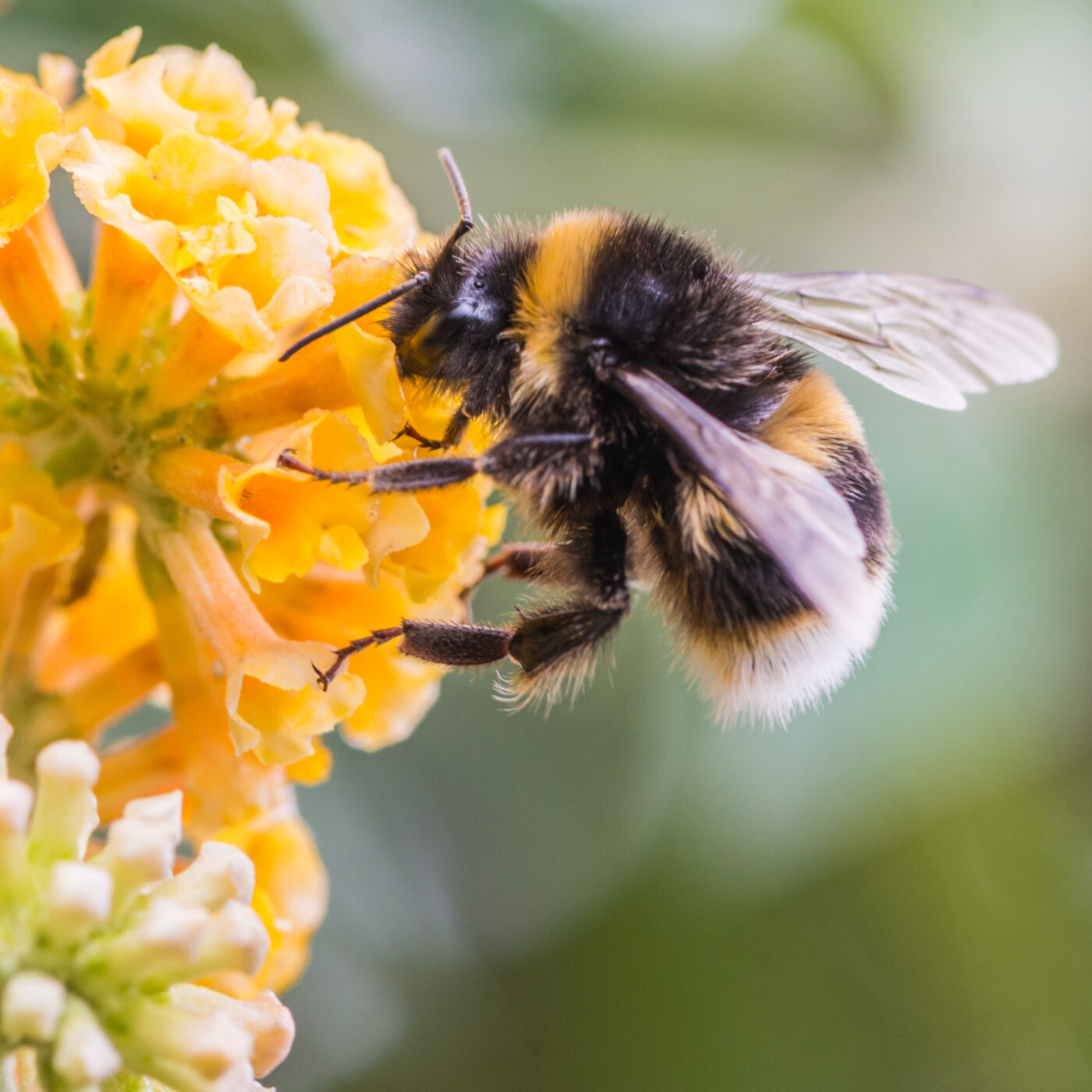Bee season is well underway. After many took part in Plantlife’s annual campaign ‘No Mow May’, which called for all garden owners and green space managers not to mow for a month, letting the grass, flowers and weeds grow wild for pollinators, we took a closer look at how our region is working hard to help save the wild bees that are so vital to our planet and how spectacular it can be to watch our green spaces burst with life…
The UK has lost nearly 97 per cent of flower-rich meadows since 1937 and as a result the story of wild bees (bumblebees and solitary bees) over the past century has been one of decline. Two species became extinct in the UK during the 20th century: Cullum’s bumblebee (Bombus cullumanus) last seen on the Berkshire Downs in 1941, and the Short-haired bumblebee (Bombus subterraneus), last seen at Dungeness in 1988 and officially declared extinct in 2000. A further eight species (a third of the remaining species) are currently listed on at least one of the English, Welsh and Scottish conservation priority species lists due to their large-scale declines in distribution.
According to the Bumblebee Conservation Trust, these declines have occurred mainly because of large-scale changes to the way the countryside is managed. First the mechanisation of agriculture, then later the need for ever-greater quantities of food and crops have conspired to hugely reduce the nationwide density of the flowering plants that bumblebees feed on, as well as the sheltered corners that they nest in over spring and summer.
As bumblebees only feed on flowers, they need far more plants than equivalent species which are able to also eat leaves or roots. They also, because of their colony-based lifestyle, need to have enough flowers available to sustain 40-400 sterile worker bees for the lifespan of the colony (potentially several months March-October) in order to produce the new reproductive individuals – males and queens – at the end of the colony lifecycle.
While it is true that changes to agricultural methods have been detrimental to bumblebees (particularly as agriculture accounts for around 70% of the UK’s land area), it should be remembered that farmers, as essentially small business owners supplying huge corporations, have little to no power in the current system. Pressure from supermarkets and ultimately from consumers – for perfect, unblemished crops, for ever-increasing yields, for the cheap food that pushes farm-gate prices significantly below the unit cost of production – is driving farmers towards agricultural intensification, towards increased chemical inputs (pesticides and fertilisers), and, increasingly, out of business.
Habitat loss is the main driver of bumblebee declines, but loss of bumblebee habitat is itself driven by many factors. Outright loss – for example building houses on a meadow – but also habitat degradation and loss of condition are both just as damaging overall. Meadows may still look green but lose proportions of their flowers – and thus their appeal to bumblebees – if treated with herbicides or even fertilisers, for instance, or if droughted. Other issues can interfere with bumblebees’ ability to use their environment. Neonicotinoid pesticides were banned, in part, because of the effect they had on bees’ brains, affecting their ability to forage efficiently. Increased temperatures (as are happening through climate change) are linked to developmental changes in some bumblebee species, and prevent foraging when it gets too hot.
What is Bristol doing to help?
The West of England Combined Authority and West of England Metro Mayor Dan Norris are working to address the ecological emergency, helping nature recover from the impact of human behaviours and changes. They want the West of England to the be the UK Bee and Pollinator Capital, home to a range of habitats for our bees and wildlife to flourish.
Norris has introduced a £1 million Pollinator Fund, which is transforming over 312,000 square metres of land to better serve this region’s pollinators like bees, moths and butterflies. It does this by providing grants of between £1,000 and £100,000 to schools, community groups and other bee-loving organisations to expand and protect bee habitats – for example, through installing “bug hotels”, upgrading a local green space or by planting fruit trees or wildflower meadows. This scheme has so far funded 13 projects – including those led by Hotwells and District Allotments and other top Bristol organisations – with more grant recipients to be announced at the end of June.
The Metro Mayor also runs the annual Bee Bold Awards, which celebrates the businesses, community groups and other ‘bee buddy’ organisations that are going above and beyond to support pollinators. Those like the Redcatch Community Garden team in Knowle and NHS Trust North Bristol – two winners in last year’s awards. The Combined Authority will be announcing the winners of 2023’s awards at Hartcliffe’s Heart of BS13 (Pollinator Fund grant recipient) as part of its Nature Family Fun Day later this month.
Norris said: “I’ve made bees a priority for the West of England Mayoral Combined Authority I lead. Because bees are bee-rilliant – they’re absolutely vital to making sure our crops are pollinated and Bristolians have food to eat year-round. My £1 million Pollinator Fund is already making such a huge difference and will be transforming over 312,000 square metres of land across the region to serve the West’s vital pollinator friends, and my annual Bee Bold Awards is showcasing the West’s best ‘bee buddy’ organisations. These are all really important steps as we look to make our amazing West of England region the best place in the whole country for our pollinators.”
Reaping the rewards
As local organisations and groups continue to work hard to help bees thrive, the region is already reaping the rewards of the initiatives put in place. In May, a rare species of bee was recorded in the West of England for the first time.
The Nomad Bee, also known as Nomada zonata, was discovered by a local volunteer on Troopers Hill in Bristol as part of a West of England Mayoral Combined Authority-funded project. The project sees residents taking part in bee surveys and other pollinator activities run by the Natural History Consortium thanks to a £100,000 grant from the Mayoral Combined Authority.
The bee, with a distinctive wasp-like appearance, is hairless and does not collect pollen for its young, but is nonetheless known as an important pollinator of plants, fruit trees and wildflowers. It was first recorded in England back in 2016, and there have been only 113 sightings of it in total – the closest one being in Stroud back in 2020. The identification has been confirmed by bee experts.
Norris said he was “thrilled” to have recorded the new species which, as a “cuckoo bee” – one that lays eggs in the nest of others – is a good sign of a “super healthy” bee population in general.

My Garden of a Thousand Bees
by Martin Dohrn
My Garden of a Thousand Bees follows acclaimed wildlife filmmaker Martin Dohrn [Attenborough’s Life That Glows] as he sets out to record all the bee species in his tiny urban garden in Bristol. Filming with one-of-a-kind lenses he forged at his kitchen table, he catalogued more than 60 different species, from Britain’s largest bumblebees to scissor bees the size of a mosquito. Over long months, Dohrn observed how differences in behavior set different species apart. He eventually got so close to the bees he could identify individuals by sight, documenting life at their level as we had never seen it before. The film received the most prestigious prize in the natural world film and television industry – the Plimsoll Golden Panda Award – and received a number of nominations at the 40th edition of the Wildscreen Panda Awards. Here, we sit down with Martin to learn more…
Tell us about what first inspired you to make My Garden of a Thousand Bees…
About 10 years ago, I noticed that there were a few wild bees nesting in the garden. Not knowing much about them, I decided to try and take photos of them to identify them, to see how many species there were. I thought there maybe five or so species and that it wouldn’t take much effort, that I could complete the job over one summer when my normal work load was lighter. How wrong I was. The bees were far harder to photograph than I was expecting. Eight summers later, the species count had got to around sixty, which seemed incredible for a small inner city garden. I told my friends, and they too were disbelieving. Many friends didn’t know there were such things as wild [solitary] bees. They only knew honey bees and bumble bees. And yet in my garden, the wild [solitary] bees outnumbered the honey bees and bumble bees many times over. I realised there was a large information gap about creatures on which the entire planet depends, were all around us and led fascinating lives, yet were barely noticed by most people.
So I spoke to a few broadcasters about a wild bee film, and met with a complete lack of interest. The idea was a non starter. Enter Covid. Just as the bee season was beginning, a lockdown of some sort seemed imminent, so I brought my macro filming gear home. Two days later, the first lockdown began, the clouds parted and a beautifully sunny spring began. Filming bees was even harder than trying to photograph them, and I found myself at the start of yet another huge learning curve. That’s at least one reason why nobody had made a wild bee film before.
What was the most surprising encounter or most interesting fact you learned about the bees along the way?
I think the most surprising thing for me was the realisation that bees have minds. Their behaviour isn’t really that different from birds. Which of course if you think about it, is obvious. Their lives are so complex and the challenges they have to deal with so variable that nature has given them the means to make decisions on the basis of what they find and what they can learn. The biggest surprise of all was the fact that many bees were so shy of my presence that I hardly saw them for the first weeks of their lives, until they became used to me and could see that I was no threat. This is completely different to honey bees and may explain partly why honey bees are so much more studied than wild bees. One thing I have found incredibly useful is a pair of Pentax Papilio binoculars. They allow you so see in close up what the bees are doing without having to move towards them (which they hate).
Tell us about how you created one-of-a-kind lenses in order to identify individual bees…
Over many years of wildlife filmmaking, I had accumulated quite an array of different lenses and had made combinations of them for different purposes. Interestingly, filming wild bees, in the wild, was different to anything I had done before. In which case, I had to build a lens system that was very light, quite long, and had extremely good resolution. This was the lens the bees eventually got used to as I moved it closer and closer to their nests.
How did this project compare to the films you’ve made around the world?
I really enjoyed the logistics of making this film; no 3am starts to get to the airport, no airports, no schlepping cases through customs, no dawn starts to film secretive animals (bees don’t normally wake until 9am or even 10am), no night filming, no mosquitos etc. But also, as we didn’t know what the bees were going to do, there was no script. I would go out in the morning perhaps hoping to film a particular piece of behaviour, and very soon get involved with filming something completely different that may even have not been observed or described before. This film could never have been made in the normal way, as without some kind of plan and some kind of script, no commissioner would risk their money.
The West of England Combined Authority is working to make our region the UK Bee & Pollinator Capital. In your experience, how can people transform their urban gardens to allow bees and other pollinators to flourish?
Most bees that live in cities are pretty versatile. As long as they have nest sites, they will prosper. Bee hotels are good for a few species. Bits of old rotting wood are favoured by others – if it is kept dry. Most bees are ground nesters. Some like bare, hard dirt, others like sandy soil, while some prefer short grass.
Let the ‘weeds’ grow. Primroses, violets, hawksbeards, brambles, buttercups, lungwort, creeping bellflower, hedge woundwort, white deadnettle, knapweeds, speedwell, sage, rosemary, wild marjoram are all favourites. You need a sort of managed chaos. It’s important not to let it all become overgrown. Bees hate darkness. Cut the grass at dusk when all the ground nesting bees have gone to bed.
Most importantly, never use insecticides. Keep cut flowers and the peel of any non-organically produced vegetable produce out of the compost bin.
What advice would you give to people wanting to document the bees in their own outdoor spaces this year?
Getting good images of bees can be tricky, especially if they don’t want to be watched. Phone cameras can be useful, but usually you need to get very close. A small DSLR or digital camera can give fantastic images. At first you will find it hard, but in time you will learn how to get close, and perhaps the bees will even get so used to you, they will show you their most intimate secrets.
But if you are really interested, you should also get the Field Guide to the Bees of Great Britain and Ireland by Stephen Falk and Richard Lewington. It is beautifully concise yet complete. This will help you identify your bees and learn the basics of their lives.
• For more information and to watch My Garden of a Thousand Bees, visit: mygardenofathousandbees.com. The film is also available on Sky Nature and Sky Now TV

Top tips on helping bumblebees from the Bumblebee Conservation Trust
The Bumblebee Conservation Trust is the only charity wholly dedicated to saving the UK’s bumblebees. It aims to inspire and enable a diverse range of people to take action to help bumblebees survive and thrive. The good news is that we can all do our bit to give these amazing insects a helping hand. As wild bees, bumblebees generally need two things to flourish: bee-friendly flowers (food), and somewhere to nest. You can support your local bumblebees by:
Growing bee-friendly plants which flower at different times of year, to give bumblebees a constant supply of food throughout their nesting season (March-October).
Mow your lawn less often, so nectar-rich wildflowers like dandelions and clover can bloom.
Grow your own fruit, veg, and herbs. Bumblebees love the flowers and will help pollinate your food.
Provide potential nesting sites for bumblebees by letting a patch of grass grow long and tangled, putting up a bird box with some dry, natural nesting material inside, or leaving a shady corner of your garden to grow a bit wilder. n
• Find out more and discover over 40 free resources at: bumblebeeconservation.org/beethechange


